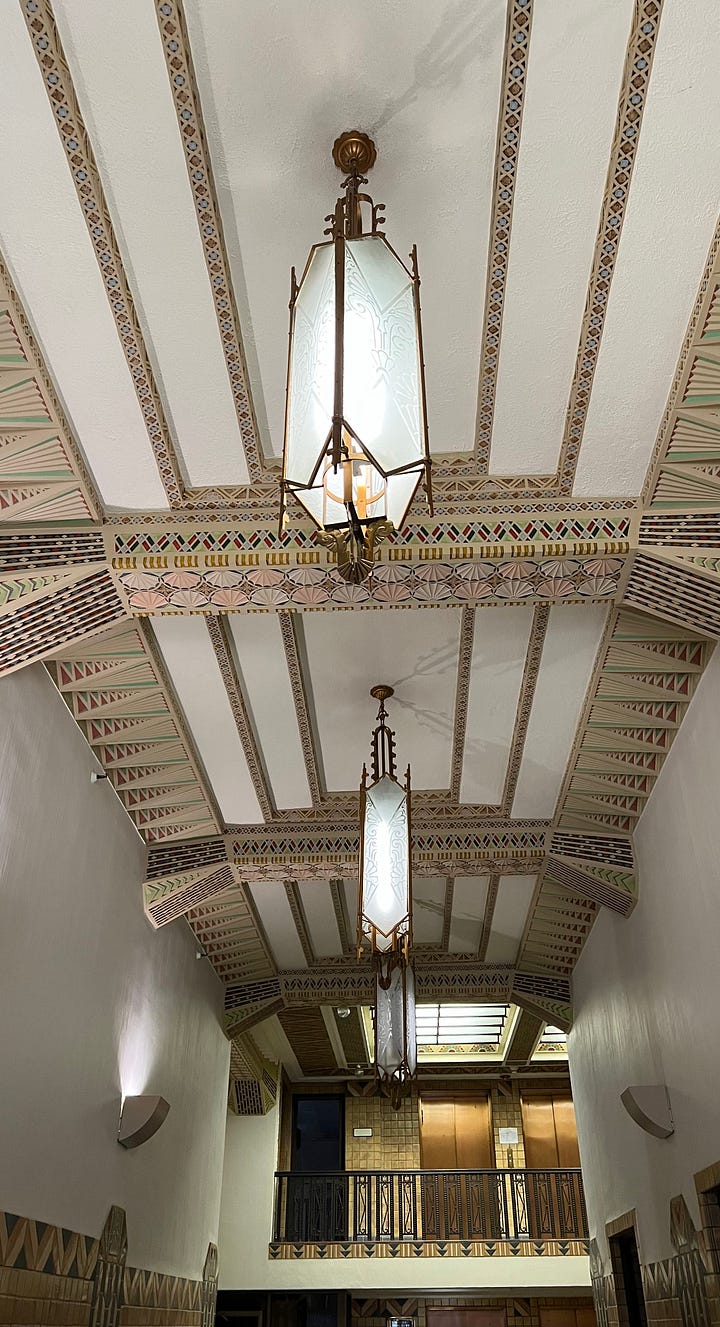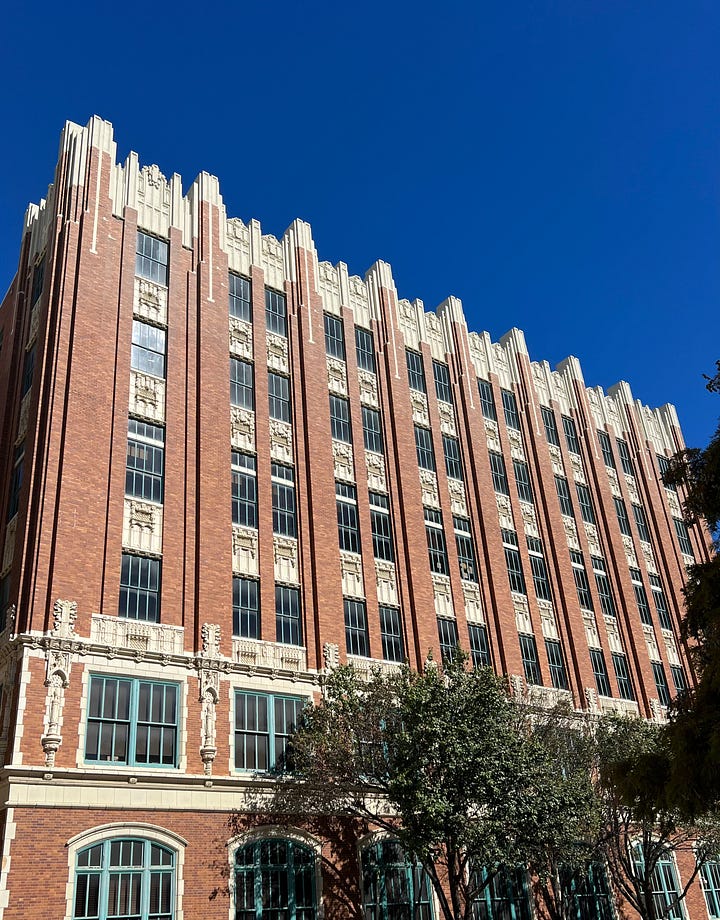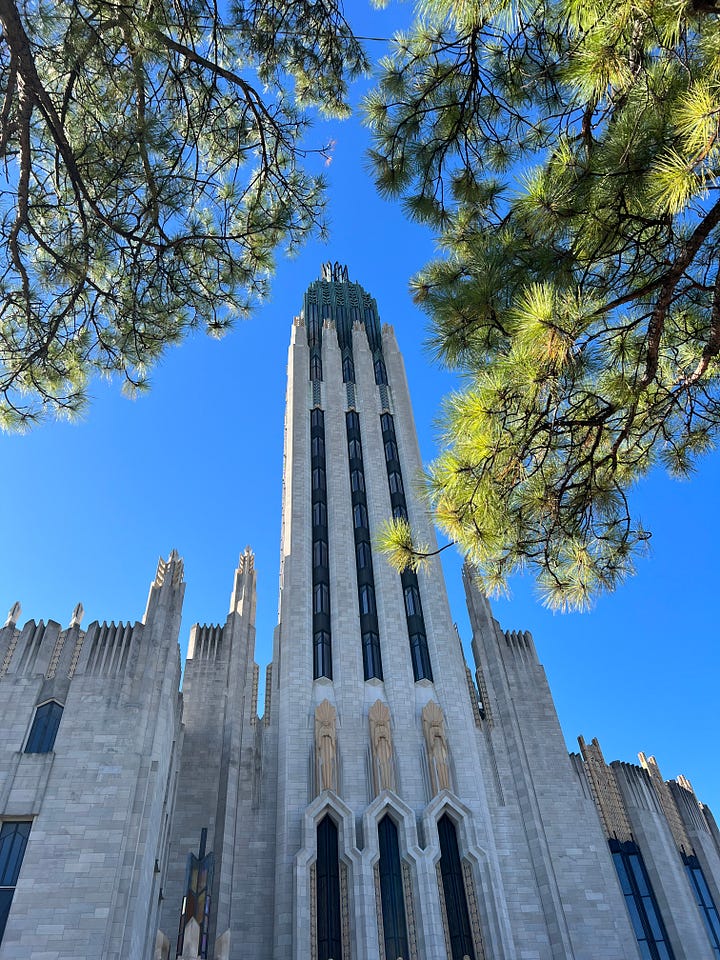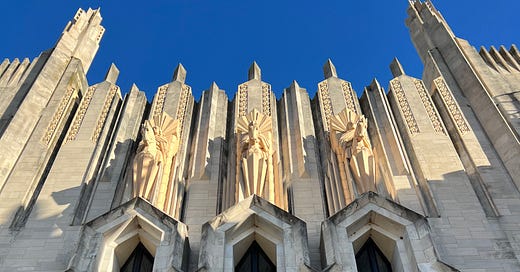Tulsa, Oil, and Teaching about how Natural Resources Change Everything
Fresh off a trip to Tulsa, I think about what oil has meant for the area.
A place to explore: Oil history and Art Deco in Tulsa
I didn’t know Tulsa was cool.
This always happens to me in the Midwest.
I’ll be headed to what I think will be a boring cow town and then I end up in some delightful metropolis (Kansas City! I love your fountains and BBQ!) or adorable college town (Lincoln, Nebraska! You’re so cute!) or a fun minor league baseball stadium in Iowa (Go Quad Cities River Bandits!)
Some day I’ll learn to stop judging places before actually going there.
One of Tulsa’s many surprises is it’s architecture. When oil was discovered in 1905, Tulsa became the Oil Capital of The World. The men who got rich from this black gold starting building.
At first, the buildings had a standard neoclassical vibe, with Roman columns and gargoyles.1
Things got interesting in the late 1920s when the Art Deco style hit the national consciousness. Oil men in Tulsa had money to burn and wanted their showy buildings to reflect the coolest trend in architecture.




Even churches got in on the act. The Boston Avenue Methodist Church made Jesus hip with it’s vertical lines, terra cotta sculptures, and zigzag details
Like everywhere else in the world, Tulsa has gone through typical cycles of change. Towering buildings shrank during the ‘40s. Route 66 fervor took over in the ‘60s. Old buildings were bulldozed in favor of parking lots in the ‘90s. Downtown was a ghost town in the 2000s. However, for the past ten years, Tulsa has been leaning into preservation and revitalization. It’s having a bit of a moment.
None of this history would have existed without those oil rigs though. If Oklahoma wasn’t atop a giant oil field, Tulsa wouldn’t be an artsy down with a razzle dazzle past. It would just be another one of those little towns that I think I’m going to drive right past.
Who am I kidding? I’d probably end up loving Tulsa anyway.
A book to read: Out Of Darkness by Ashley Hope Pérez
Betcha thought I was going to write about Killers of the Flower Moon, weren’t you?
Nope.
Intrigued by the premise2 and the fact that I’d recently been to Tulsa, I saw the movie. It was…fine. I’d thought the movie was going to be more about the Osage, but it was all about the men who killed them, which wasn’t really as engaging.
My favorite parts of the three and a half hour flick was when we could hear Taylor Swift’s Eras Tour from the auditorium next door.
Obviously, I’m not really a movie person. I’ll read the book some day and probably like it way better than the movie. Maybe I’ll write about it then. Stay tuned.
But since that read hasn’t happened yet, I’m delighted to recommend OUT OF DARKNESS by Ashley Hope Pérez.
The book doesn’t take place in Tulsa, but in an oil rich town in in East Texas. The historical fiction tales culminates in the New London school explosion, an actual event that happened in 1937. The natural gas explosion killed 200+ students and teachers at the school.
Much like Tulsa, oil money also flowed into New London in the early 1900s. New London High School was one of the wealthiest rural schools in the nation. Also like Tulsa (and most American cities), New London was divided racially - not only between White and Black communities, but also within the Mexican American communities.
The novel follows Naomi, our Mexican American protagonist, and Wash, the Black boy whom she falls in love with. Their love story is gorgeous and exquisitely written. Where Naomi is bitter and hard, Wash is all warmth.
Naomi’s White (yes, that matters) stepfather is our antagonist. His relationship with Naomi is abhorrent and also exquisitely written. Naomi’s stepfather is the reason for the extensive list trigger warnings this book comes with.
The book has been banned in several school districts for it’s (not insignificant) depictions of sex and rape. Check out the author making fun of an enthusiastic book-banner here.
Like Killers of the Flower Moon and the entire town of Tulsa, Out of Darkness would not have a setting if it wasn’t for oil. Naomi’s father works in the oil fields, and much of the wealth that divides the population is derived from oil. Just as oil revenue built Tulsa, and spelled doom for some Osage families, it worked to divide the New London community in Out of Darkness.
A lesson to teach: Natural resources Change Everything.
How communities use their natural resources is a hot topic for any Geography, History, Economics, or Social Studies teacher.
Some communities make money selling their resources, like Tulsa during their oil boom years.
Some communities refuse to sell their resources. China and the resulting Opium Wars is a good example.
Other communities leave their resources alone only to be exploited. King Leopold II killing 10 million Congolese for rubber profits is one of the more brutal examples here.
Often, communities use their own resources themselves. During the Industrial Revolution, London discovered the realities of air pollution as they got rich from coal powered factories. China is reliving this asthmatic-inducing hell today.
And sometimes, communities keep their resources secret. The vibranium in Black Panther’s Wakanda is my go-to example for this one.
No doubt about it, when people discover new ways to use natural resources, things change. I teach this concept to my students by having them draw a quiet little town. I give them a few things to draw (homes, a river, etc.) Then, natural resources are discovered in the town and everything changes. They have to add factories, roads, and stores to their not-so-rural town.
This is a pretty common simulation for teaching urbanization and/or the industrial revolution and there are a few similar lesson plans floating around the internet. Feel free to use mine! Give the students a big piece of paper, a pencil, and read them the following story/directions. Students love this activity. It’ll be a fun teaching day :)
Actually most of the creatures adorning Tulsa’s oldest buildings are not gargoyles but grotesques. To be classified a gargoyle, the figure must include some sort of spout to divert water.
The Osage Nation got rich from oil money in the 1920s. White dudes (aka Leonardo DiCaprio) married into the tribe and killed off family members to get rich.




Fabulous Article ! Oh No though - watch out for Spoilers !
Like most towns in OK, the juxtaposition of the obscene wealth of the planet rapers with homes having plywood over windows in eyesight was soul crushing to me.
Oklahoma is NOT OK!!!